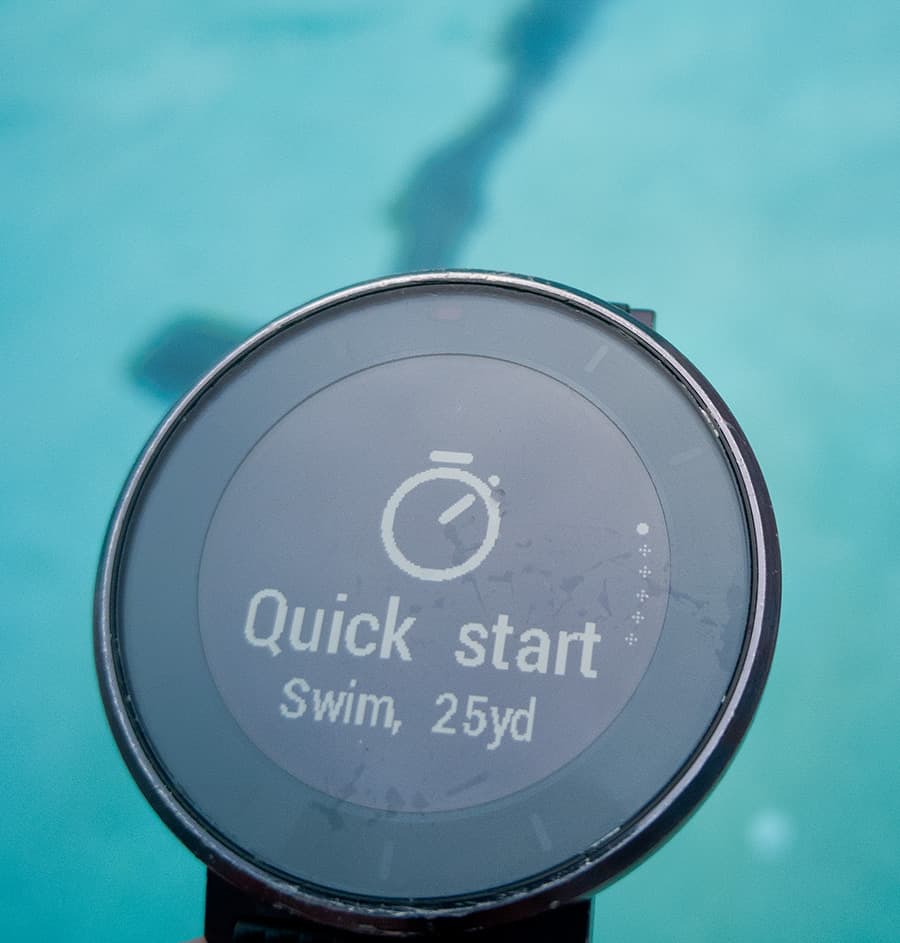
Above: Huawei’s new Fit smartwatch makes some interesting design choices but needs more software smarts. Photo by Mark Lyndersay.
Originally published on March 28, 2017
Huawei’s new Fit is a fresh entry in the field of biometric active wear. I’d previously tested Samsung’s similarly named Gear Fit, but the Huawei watch is a very different beast.
For one thing, I started testing this watch two months ago and I’ve only taken it off to charge it (every eight days, on average) and when I go to the beach.
The Samsung device was sleekly moulded for the wrist and sported a small, but attractive collection of watch faces and backgrounds. The Huawei Fit is a more standardised disc of metal and glass with a black and white screen that takes its cues from the Kindle.
The payoff is really long battery life the cost is a certain unnerving simplicity to the black and white (no grays) display. Huawei would do well to explore the heyday of bitmapped art (1984-1994) to see what’s possible with just two colours on a tiny screen.
The watchfaces, which look like they were drawn in MacPaint on a MacPlus, range from hideous to functional. In return, the screen draws tiny sips of power and the device handily outstrips its promise of six days of battery life.
To test the new H-Fit, I put it on and didn’t take it off for a week, not until the battery indicator seemed to be suggesting that it was time for a recharge.
The tiny rectangle of white is your only power indicator. I couldn’t find anything that offered a numerical status update. It was also wrong. Once I plugged in the charger, the device rather proudly announced that it still had 29 per cent of its charge left.
So what did I do with it during that first week?
Well, apparently I walk a lot more than I thought. You can set exercise goals and activate sessions from the watch, but for the most part, the communication is one way, from phone to wearable device.
Since the only place a normal Trini can’t wear the watch is in the sea, there’s no reason to take it off and the lightweight disc of metal and Gorilla Glass is easy to forget once you’re wearing it. I don’t normally wear a watch, indeed I haven’t for 40 years, but I fell into wearing it more easily than I would have thought possible.
I’d hoped to be able to use it for lap swimming, but it’s useless for that. On the swim setting, the device just runs a timer on the duration of your swim. The Huawei Fit has accelerometers and sensors in it, but it can’t fulfil the most basic requirement of a swim timer, measuring individual laps.
You can find swim watches that sense lap turns, estimate pool size and gather useful statistics about a swim session for US$85, a fitness smartwatch intended for use in a pool should be able to do at least that.
I get more useful information from a lap counter ring I’ve been using to log laps manually for the last three years.
The heart rate measurement continues in the pool though, so I did find out something I didn’t know before.
Of greater value was the information the Fit gathered while I was asleep. After looking at statistics that suggested that I wasn’t having enough deep sleep, I began to make changes in my routine to improve sleep quality.
Overall I quite like the Huawei Fit and the design and technology choices that went into its development are hardly deal breakers for me.
There may be some who are unprepared for a watch that’s so retro in its display ambitions, but it’s unquestionably a tradeoff that adds value and convenience to wearing the device.
Software updates to the Huawei Fit have been showing up more frequently recently. I keep hoping for new watchfaces and added utility in the lap measurement, but distance hikers and runners will find a lot to like in a lightweight disc that’s built to take punishment and has exceptional battery life.
[Updated, August 11, 2017]

Improved swim tracking on the Huawei Fit includes a range of markers (visible in the screen capture at right) that are useful for comparison and evaluation.
Six months later, the device is a bit more battered but still works well. I wore it almost continuously for around four months after an update significantly enhanced sleep tracking, which fascinated me.
This proved problematic, because I began to develop a skin rash on my wrist, and I’m still trying to figure out what’s been causing that and I’ve been subjecting the watchband to several different cleaning solutions to figure out what’s been causing the irritation.
I believe the enhanced sleep tracking took a hit on battery life as well, dropping it from five days to just three. That’s been borne out recently, because I now wear the watch for task specific needs and battery life has almost doubled.
On a more positive note, an update last month added dramatically enhanced the swim tracking that was available in the Huawei Fit on introduction.
I have some issues with how cluttered the screen becomes during tracking and would love to see it simplified to current time, elapsed time and total laps, which I might stand a chance of being able to read during an active swim.
There’s no problem with what the device actually records and uploads to the Huawei Wear app once it reconnects with the phone and how it’s displayed in the Huawei Health app, visible above.
It’s a remarkable example of how a device with appropriate sensors for a range of tasks can be updated with software to become more useful to its users. Huawei is to be congratulated for improving its watch device after sale in such significant ways.

